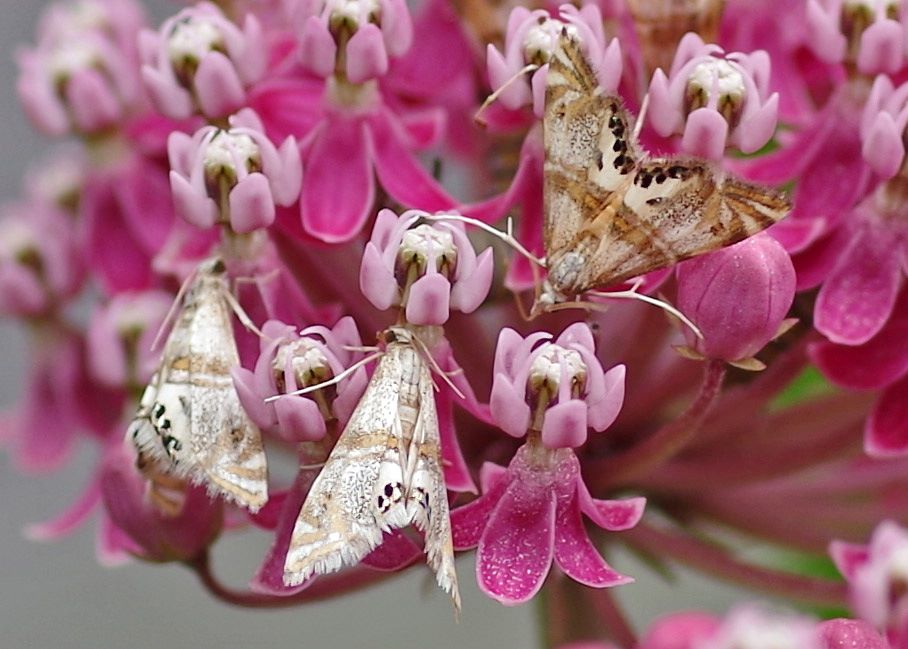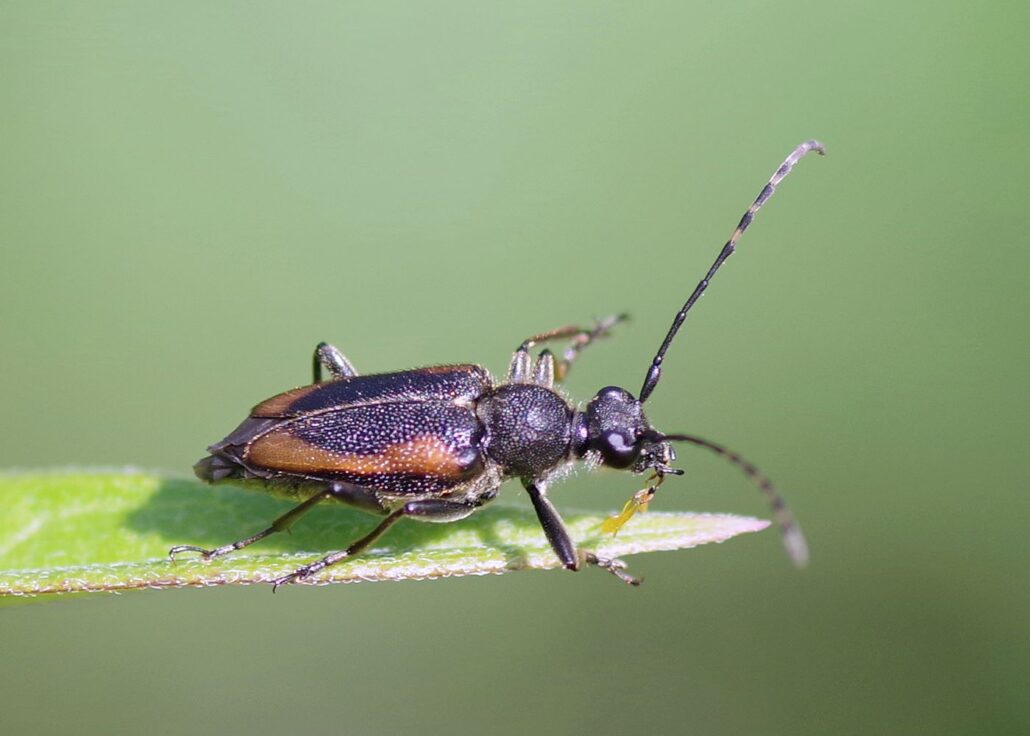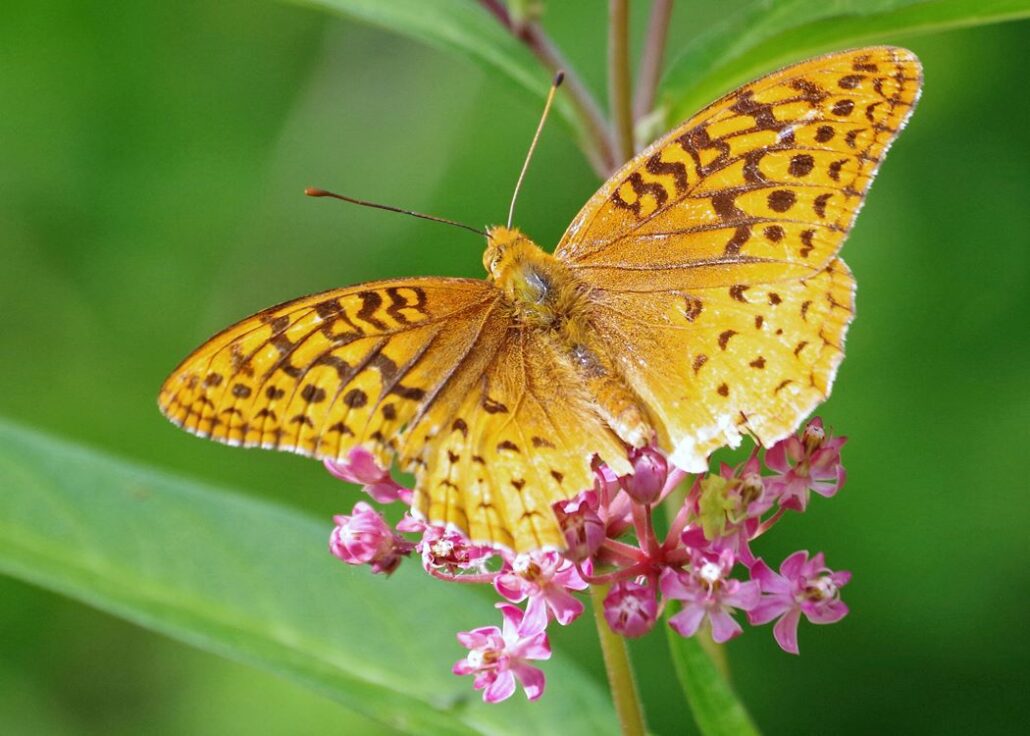
by Kate Redmond
Moths – Four Very Short Stories
Greetings, BugFans,
Everybody likes butterflies (the BugLady would not like to meet the person who dislikes butterflies). But, in the order Lepidoptera, butterflies are just the tip of the iceberg – the heavy lifting is done by moths. There are in the neighborhood of 180,000 species of Lepidoptera worldwide (“10% of the total described species of living organisms,” says Wikipedia), and about nine-tenths of them are moths. Only around 700 of North America’s 12,000 species of Lepidoptera are butterflies.
Moths often languish in the BugLady’s picture files because: A) They can be tough to identify; and B) Most are not notorious enough to have drawn much attention to themselves, so their biographies are hard to find and are more like short stories.
Three of today’s four moths are in the family Geometridae – the “earth-measurers” or “loopers” – so-named for the gait of their caterpillars, the inchworms. They are slim, well-camouflaged caterpillars with long abdominal segments, but with fewer and reduced abdominal prolegs (the fleshy, unjointed “helper” legs – the six real legs are on the thorax). Having one set of prolegs toward the front of the abdomen and one set at the rear leaves them with no visible means of support in the middle, so they “inch” – move their front end forward and then hike the rear end up to follow it, measuring the earth as they go.
About the Geometrids, Wagner, in Caterpillars of Eastern North America, says “Whether measured in terms of abundance or biomass, loopers are among the most important forest lepidopterans in Eastern North America. They are an especially important component of the spring caterpillar fauna of deciduous forests, where they are a staple in the diets of many forest-nesting birds.”

The NORTHERN PETROPHORA MOTH(Petrophora subaequaria)
The BugLady found this pretty moth in May at a small, acid bog that she frequents. The Northern Petrophora moth is a Northeastern moth that is close to the west edge of its range in Wisconsin. Caterpillars https://bugguide.net/node/view/1503546/bgimage are abroad throughout summer and are oligophagous (they feed on a variety of related plants) – look for them on ferns, including bracken fern. The caterpillars have been described as “strong jumpers.”

The COMMON METARRANTHIS (Metarranthis hypochraria)
The caterpillars feed in early summer on a number of trees and shrubs, especially in the genus Prunus (cherries, apples, and plums) and are stick mimics, but mature caterpillars are hard to find. Wagner speculates that they may move down from the leaves onto the trunk or into the litter by day. He also says that (of course) “the taxonomy of the group is in need of review.” Many adults in this genus fly during the day and they often perch on the ground, cryptic against the fallen leaves.

The THREE-SPOTTED FILLIP (Heterophleps triguttaria)
The BugLady found this small (3/4” wingspan), distinctly-marked moth at the same bog as the Petrophora moth. It’s found throughout the spring and summer in wet woodlands and marshes from Colorado to Ontario to Quebec to North Carolina, and according to the “Moths of North Carolina” page on the NC Parks website, the majority of its other genus members live in India and China.
It’s monophagous – it had long been thought that the caterpillar host plant was maple, but caterpillars that were fed maple leaves in the lab wouldn’t eat them, and it turned out that the caterpillars host is Clearweed, a kind of nettle.
So – what is a “fillip?” There are several, very diverse meanings, but an archaic one seems to fit in this context, “a movement made by bending the last joint of the finger against the thumb and suddenly releasing it; a flick of the finger.” “To propel a small object with a flick of the finger.” “Fillip is considered a phonetic imitation of the sharp release of a curled-up finger aimed to strike something.” And it turns out that, according to the NC Parks website, “When disturbed the larvae form a tight coil and are known to hurl their frass pellets.”

And the MORBID OWLET (Chytolita morbidalis)
The Morbid Owlet is in the family Erebidae and the subfamily Herminiinae, the litter moths, some of whose caterpillars feed on live leaves, while others feed on algae, lichens, fungi, dung, decomposing vegetation or insects, organic stuff they find around animal nests. Wagner describes them as lethargic caterpillars that avoid the light and that play dead when bothered. Bugguide.net says that “morbidalis” comes from “morbus,” meaning “disease” and probably refers to the “sickly pale color” of the moth. The “snout” protruding from the head is formed by the “labial palps,” which have a sensory function in feeding.
Morbid Owlet caterpillars eat dead leaves (they’re detritivores) and low vegetation like dandelions. Wagner says that “they flatten the rear of the body in a manner that suggests a false head.”
Using her Peterson Field Guide to the Moths of Northeastern North America, the BugLady originally ID’d this moth as a Stone-winged Owlet Moth (Chytolita petrealis), but when she Googled it, it kept coming up as the Morbid Owlet (Chytolita morbidalis). It appears that a recent taxonomic review of the genus (done after her moth book was published) lists Chytolita petrealis as a synonym of Chytolita morbidalis – basically, same species – and now the only member of its genus north of the Rio Grande. The Stone-winged Owlet Moth form is said to be smaller and darker than the Morbid Owlet form. Bugguide.net, whose account must also have been written before the review, lists the habitat of the Morbid Owlet as “deciduous woods and edges; generally drier or less boggy habitat than Chytolita petrealis.”
Not so fast, says the North Carolina Parks Chytolita petrealis page. “Chytolita petrealis is currently treated by some authorities to be a synonym of morbidalis, following determination that the type of petrealis was a morbidalis. Prior to that realization, however, the name petrealis had been applied to a distinct and much rarer species in the Southeast. The authors who sunk petrealis did not realize this so our petrealis has no name at the moment. To make things more complicated, there is another undescribed thing like it from the mountains (2-3 specimens known) whereas the petrealis that has been most widely recognized is present primarily in the Coastal Plain.” And, it goes on to say “The majority of our records come from swamp and floodplain forests, forested shorelines, as well as peatlands and other wet forests.”
The BugLady found it in that same acid bog as the Petrophora and the Fillip moths.
Fun Fact about the Northern Petrophora Moth:
The species was described by 19th century British entomologist Francis Walker. He published like crazy, shared his knowledge generously, and was respected by many of his peers. Between 1848 and 1873, he worked at the monumental task of cataloging the insects in the collection of the British Museum, a task for which he was paid one shilling for each new species he determined and one pound for each new genus (and where he ended up describing 16,000 species). Alas, he turned out to be a little careless/enthusiastic, sometimes assigning multiple different scientific names to specimens of the same species. One source said that he was no worse than many other entomologists of his day – imagine doing a job like that without the kinds of communication, magnifying, and imaging tools we have today – but the huge scale he was working on multiplied his errors.
After his death, an unsigned obituary began “More than twenty years too late for his scientific reputation, and after having done an amount of injury almost inconceivable in its immensity, Francis Walker has passed from among us.”
Brutal!
Kate Redmond, The BugLady
Bug of the Week archives:
http://uwm.edu/field-station/category/bug-of-the-week/




































